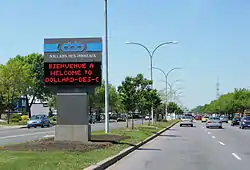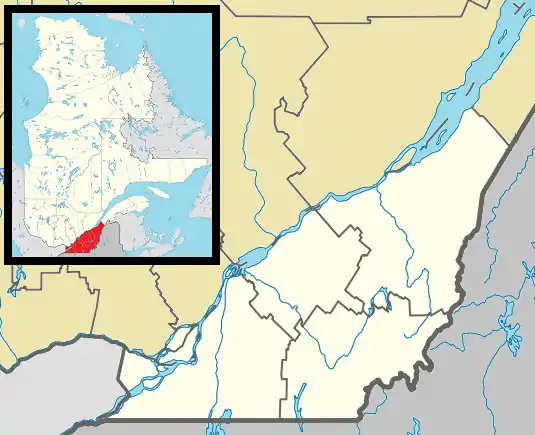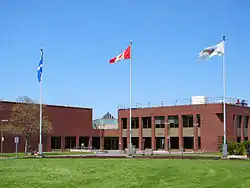Dollard-des-Ormeaux
Dollard-des-Ormeaux (French pronunciation: [dɔlaʁ de zɔʁmo]; commonly referred to as D.D.O. or simply Dollard) is a predominantly English-speaking on-island suburb of Montreal in southwestern Quebec, Canada. The town was named after French martyr Adam Dollard des Ormeaux.
Dollard-des-Ormeaux
Dollard-Des Ormeaux | |
|---|---|
 | |
 Flag  Coat of arms | |
| Nicknames: Dollard, D.D.O.[1] | |
| Motto(s): Viribus Unitas | |
 Location on Island of Montreal. (Outlined areas indicate demerged municipalities). | |
 Dollard-des-Ormeaux Location in southern Quebec. | |
| Coordinates: 45°29′N 73°49′W[2] | |
| Country | |
| Province | |
| Region | Montreal |
| RCM | None |
| Founded | 1924 |
| Constituted | January 1, 2006 |
| Government | |
| • Mayor | Alex Bottausci |
| • Federal riding | Pierrefonds—Dollard |
| • Prov. riding | Robert-Baldwin |
| Area | |
| • Total | 15.2 km2 (5.9 sq mi) |
| • Land | 15.2 km2 (5.9 sq mi) |
| Population (2016) | |
| • Total | 48,889 |
| • Density | 3,223.4/km2 (8,349/sq mi) |
| • Pop 2011-2016 | |
| • Dwellings | 17,210 |
| Demonym(s) | Dollardian |
| Time zone | UTC−5 (EST) |
| • Summer (DST) | UTC−4 (EDT) |
| Postal code(s) | H9A, H9B, H9G |
| Area code(s) | 514 and 438 |
| Highways | No major routes |
| Website | www |

The town was merged with the city of Montreal in 2002 and became part of the borough of Dollard-Des Ormeaux–Roxboro. When residents were offered the option, they chose to leave the City of Montreal and the town was reinstated as a separate entity in 2006.
Name
In 2001, the official Commission de toponymie du Québec ruled that the correct way to write the city's name was Dollard-Des Ormeaux[2] (one hyphen, one space, all title caps). However, this was not widely accepted and is rarely used in practice. In particular, as of 2014, the city's own website does not use this way of writing the city's name.[5]
History
Early history
In 1714, the area was part of the Parish of St-Joachim de Pointe-Claire. It became part of the Parish of Ste-Geneviève when it detached from Pointe-Claire in 1845.[6]
On July 29, 1924, Dollard-des-Ormeaux detached from the Parish of Ste-Geneviève and became a separate municipality in response to a tax imposed by the Parish road improvements on Gouin Boulevard. Its first mayor was Hormidas Meloche.
The town's name honours the French martyr Adam Dollard des Ormeaux, who was killed by the Iroquois at Long Sault in 1660.
Later history
The City of Dollard-des-Ormeaux obtained a new charter and was incorporated as a city on February 4, 1960.
Dollard-des-Ormeaux was originally a bedroom community in the early 1960s. The population was barely a few hundred in 1960, and within 10 years, exceeded 15,000[7]
One of its original main axes, Anselme-Lavigne Street in the Westpark neighbourhood, is named for a farmer who sold his land to the Belcourt Construction Company. Many of the streets in the Sunnydale neighbourhood, including "Sunshine" and "Hyman", are named for members in the prominent Zunenshine family who owned Belcourt. The community is a mixture of residential and commercial properties. Des Sources and St-Jean Boulevards are its main commercial arteries, and are represented by the two vertical lines in the city's official logo. The three circles in the logo, from left to right, respectively represent the St-Jean Sector, the Westpark Sector and the Sunnybrooke Sector. The three circles and two vertical lines in the logo represent the city's geography and artfully spell out "ddo".
The Town Hall was located in a house on Des Sources Boulevard in the early 1960s, and was moved to an 1806 French-Canadian farmhouse in 1964.
When Canada's centennial anniversary was due to occur, the town decided to create a "Centennial Park," featuring a man-made lake and hills. It was suggested to use this project for a reservoir for stormwater drainage, as the city was faced with the need to expand surface drainage pipes. The project was announced September 8, 1966.[8] However the project ran into problems and became a local scandal and a major drain on resources. It was finally completed in the 1970s, albeit overdue and overbudget.
Dollard-des-Ormeaux was included in the Montreal Urban Community when that government was created in 1970.
Recent years
On January 1, 2002, as part of the 2002–2006 municipal reorganization of Montreal, it merged with the city of Montreal and became part of the Dollard-Des Ormeaux–Roxboro borough. After a change of government and a 2004 demerger referendum, Dollard-des-Ormeaux was reconstituted as an independent city on January 1, 2006. It is now the Montreal Island's most populous city outside Montreal.
Albeit, not served by the Montreal Metro, it is planned that the city would be served by the planned Réseau électrique métropolitain light rail system with at least one station at the juncture of Highway 40 and Des Sources boulevard.
Parks and facilities
Dollard is known for its many well-attended green spaces, providing a park within one kilometre of each home.[9] Notable parks include Centennial Park, Westminster Park, Baffin Park and Terry Fox Park. Edward Janiszewski Park was named after the longest-reigning mayor of the city.
Dollard-des-Ormeaux is home to the Dollard Civic Centre, which serves as city hall, the public library and houses ice skating and swimming facilities.
Sports
Dollard is home to many juvenile sports teams, including hockey, soccer, baseball, swimming and ringette. In 2013, the city received $20 000 from Kraft Le Hockey Continue program in recognition of the efforts of Lance Taylor Townend, an administrator and coach with the Dollard Hockey Association.[10]
Government
The city government[11]
- Errol Johnson (District 2)
- Mickey Max Guttman (District 3)
- Herbert Brownstein (District 4)
- Morris Vesely (District 5)
- Valérie Assouline (District 6)
- Pulkit Kantawala (District 7)
- Colette Gauthier (District 8)
Since the city's incorporation in 1960, there have been seven mayors. They are Alfred Labrosse (1960–1963), Frederick T. Wilson (1963–1968), Gerald Dephoure (1968–1978), Jean Cournoyer (1978–1982), Gerry Weiner (1982–1984), Edward Janiszewski (1984–2017) and Alex Bottausci (2017–present).
Edward Janiszewski's 33-year reign as Mayor of DDO makes him the longest-serving Mayor in the city's history, and the second longest-serving Mayor in the history of Canada, behind Hazel McCallion. He was first elected to city council in 1978 before becoming mayor in 1984. During his tenure, he also oversaw the construction of Dollard-des-Ormeaux's famous library and many of the additions which were made to the civic centre. At the time of his defeat in 2017, the city was left with a surplus of $15 million.[12]
Municipal Patrol

Established in 1980, a municipal patrol service was initially created to enhance public safety in the city and to enforce parking violations after the merger of police departments on the Island of Montreal. The service is responsible for public safety, municipal by-law enforcement, crime prevention, emergency measures, and community relations. Though much controversy surrounds the concept of municipal security agencies. The department was lead by long time Captain Gerry Lauzon for 33 years before his retirement June 29, 2018. Former Lieutenant Matt Sauerman was promoted to captain (by interim).
Education
The Lester B. Pearson School Board operates four Anglophone public schools in the area. Schools operated by the LBPSB include Springdale Elementary School, Sunshine Academy, Westpark Elementary School, and Wilder Penfield Elementary School. Beechwood Elementary and Kingsdale Academy in Pierrefonds-Roxboro also serve portions of Dollard-des-Ormeaux.[13]
The Commission scolaire Marguerite-Bourgeoys operates Francophone public schools,[14] including École primaire Dollard-Des Ormeaux, the École primaire du Bois-de-Liesse, the École primaire Saint-Luc, and the École secondaire des Sources.
Private schools include West Island College, Emmanuel Christian School, and Hebrew Foundation School.
Demographics[15]
| Year | Pop. | ±% |
|---|---|---|
| 1966 | 12,297 | — |
| 1971 | 25,215 | +105.1% |
| 1976 | 36,837 | +46.1% |
| 1981 | 39,940 | +8.4% |
| 1986 | 43,089 | +7.9% |
| 1991 | 46,922 | +8.9% |
| 1996 | 47,826 | +1.9% |
| 2001 | 48,206 | +0.8% |
| 2006 | 48,930 | +1.5% |
| 2011 | 49,637 | +1.4% |
| 2016 | 48,889 | −1.5% |
| Language | Population | Percentage (%) |
|---|---|---|
| English | 26,060 | 61% |
| French | 6,910 | 16% |
| Other | 10,040 | 23% |
| Language | Population | Percentage (%) |
|---|---|---|
| English | 18,995 | 42% |
| French | 7,590 | 17% |
| Other | 18,715 | 41% |
| Ethnicity | Population | Percentage (%) |
|---|---|---|
| Not a visible minority | 29,540 | 61.2% |
| Visible minorities | 18,735 | 38.8% |
See also
- List of former boroughs of Montreal
- Montreal Merger
- Municipal reorganization in Quebec
References and notes
- Dollard des Ormeaux (Montreal District) - What does DDO stand for? Acronyms and abbreviations by the Free Online Dictionary
- Commission de toponymie du Québec: Banque de noms de lieux du Québec: Dollard-Des Ormeaux
- "Ministère des Affaires municipales, des Régions et de l'Occupation du territoire: Dollard-des-Ormeaux". Archived from the original on 2012-05-01. Retrieved 2012-03-11.
- Parliament of Canada Federal Riding History: PIERREFONDS--DOLLARD (Quebec)
- Ville de/City of Dollard-des-Ormeaux website homepage Archived 2009-08-31 at the Wayback Machine
- The Canadian Encyclopedia
- DDO History
- "Dollard Concludes agreement..." North Shore News. May 9, 1968.
- Parks and playgrouds. City of Dollard-des-Ormeaux.
- https://ville.ddo.qc.ca/ma-municipalite/membres-du-conseil# Laurence Parent (District 1)
- "School Board Map." Lester B. Pearson School Board. Retrieved on September 28, 2017.
- "ÉCOLES ET CENTRES." Commission Scolaire Marguerite-Bourgeoys. Retrieved on December 7, 2014.
- http://ville.montreal.qc.ca/pls/portal/docs/PAGE/MTL_STATS_FR/MEDIA/DOCUMENTS/PROFIL_SOCIOD%C9MO_DDO%202016.PDF